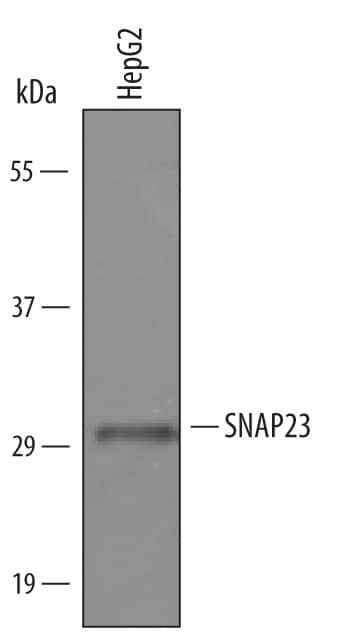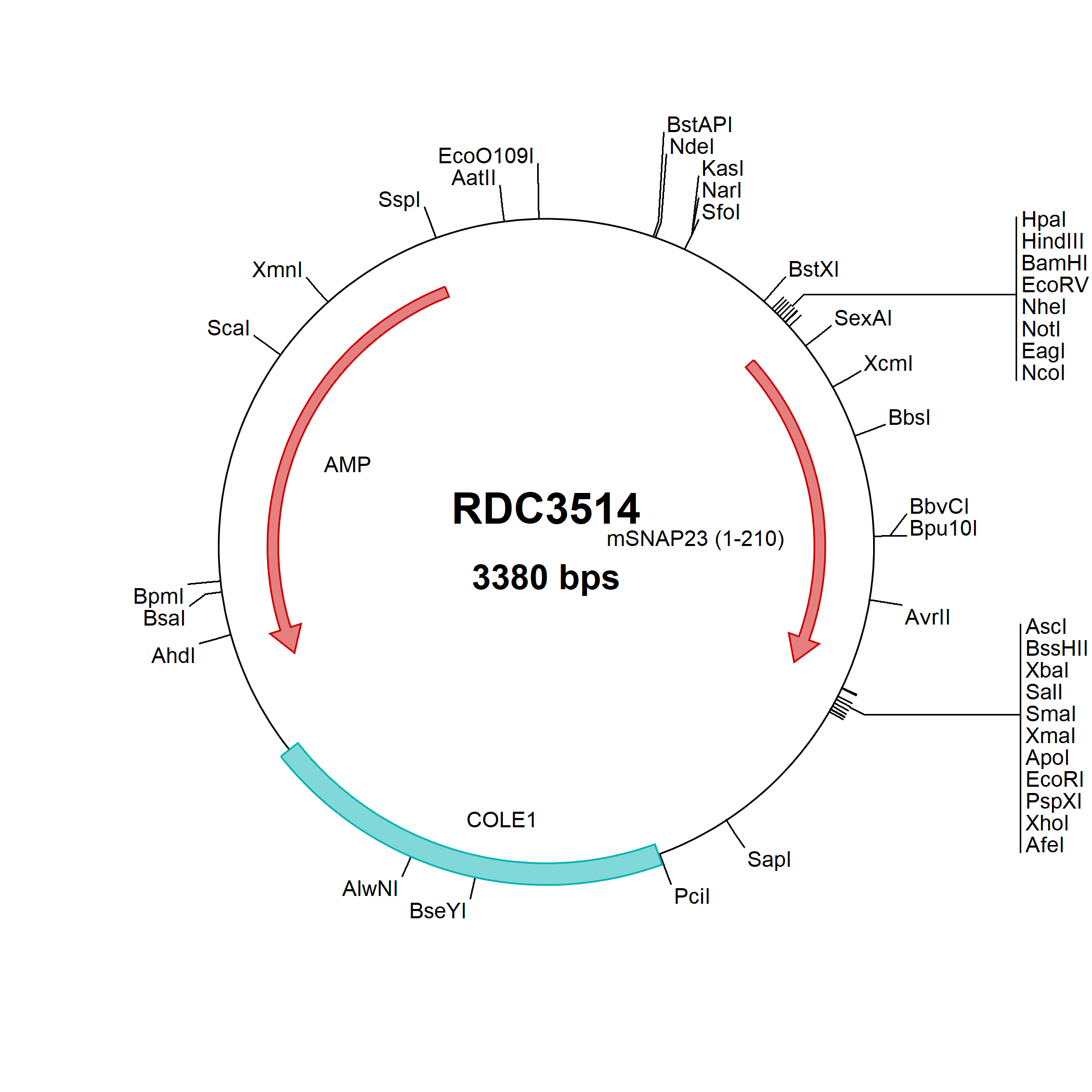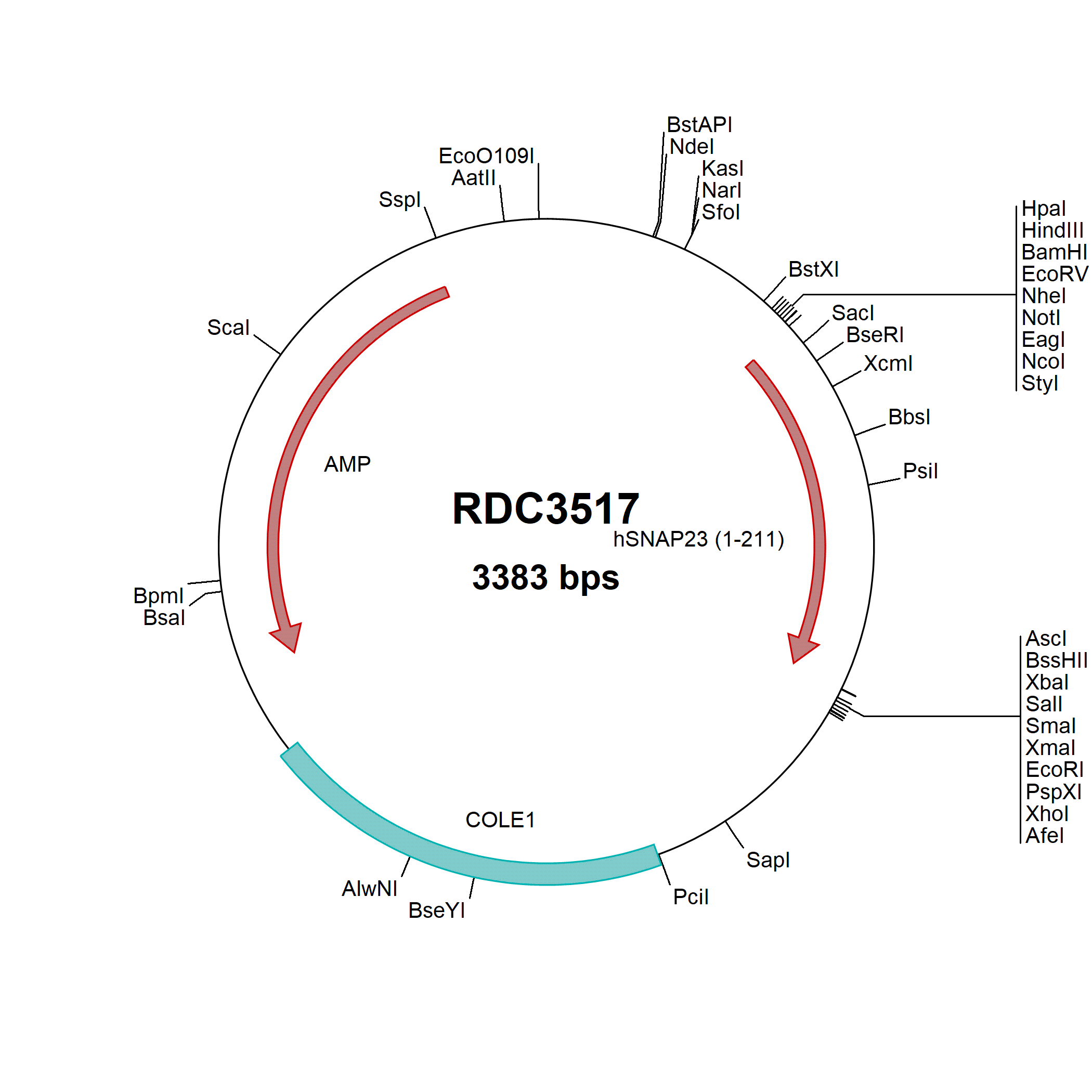SNAP23 Products
Synaptosomal-associated Protein 23 (SNAP23), also known as Syndet, is a member of the SNAP25 family of t-SNARE proteins that play a role in vesicle exocytosis. Human SNAP23 is 211 amino acids (aa) in length and has a predicted molecular weight of approximately 23 kDa. It contains two t-SNARE coiled-coil homology domains at aa 14-76 and 146-208. There is one splice variant, termed SNAP23B, that contains a deletion of aa 90-142. The canonical sequence of human SNAP23 shares 87% aa sequence identity with the mouse and rat orthologs. It has been suggested the SNAP23 may function as both a v-SNARE and a t-SNARE. As a v-SNARE, SNAP23 can interact with Syntaxin-6 at the cell membrane.
As a t-SNARE, it acts in conjunction with Syntaxin-4 to bind with VAMP-2 and VAMP-8 on the vesicle membrane. In either case, this approximates the two membranes, which subsequently fuse to create a pore. SNAP23 is expressed in multiple cell types including adipocytes, mast cells, platelets, and neutrophils. It is critical for vesicle exocytosis in these non-neuronal cells. In the nervous system, high SNAP23 expression has been detected in the postsynaptic density of dendritic spines. As a consequence, it has been suggested that in the central nervous system, SNAP23 is not involved in the exocytosis of neurotransmitters, but may instead play a role in the trafficking of postsynaptic glutamate receptors.
Products:
13 results for "SNAP23" in Products
13 results for "SNAP23" in Products
SNAP23 Products
Synaptosomal-associated Protein 23 (SNAP23), also known as Syndet, is a member of the SNAP25 family of t-SNARE proteins that play a role in vesicle exocytosis. Human SNAP23 is 211 amino acids (aa) in length and has a predicted molecular weight of approximately 23 kDa. It contains two t-SNARE coiled-coil homology domains at aa 14-76 and 146-208. There is one splice variant, termed SNAP23B, that contains a deletion of aa 90-142. The canonical sequence of human SNAP23 shares 87% aa sequence identity with the mouse and rat orthologs. It has been suggested the SNAP23 may function as both a v-SNARE and a t-SNARE. As a v-SNARE, SNAP23 can interact with Syntaxin-6 at the cell membrane.
As a t-SNARE, it acts in conjunction with Syntaxin-4 to bind with VAMP-2 and VAMP-8 on the vesicle membrane. In either case, this approximates the two membranes, which subsequently fuse to create a pore. SNAP23 is expressed in multiple cell types including adipocytes, mast cells, platelets, and neutrophils. It is critical for vesicle exocytosis in these non-neuronal cells. In the nervous system, high SNAP23 expression has been detected in the postsynaptic density of dendritic spines. As a consequence, it has been suggested that in the central nervous system, SNAP23 is not involved in the exocytosis of neurotransmitters, but may instead play a role in the trafficking of postsynaptic glutamate receptors.
Products:
| Reactivity: | Human |
| Details: | Sheep IgG Polyclonal |
| Applications: | WB, ICC |
| Reactivity: | Human, Mouse, Rat |
| Details: | Rabbit IgG Polyclonal |
| Applications: | IHC, WB, ICC/IF |
| Reactivity: | Human |
| Details: | Mouse IgG1 kappa Monoclonal Clone #2F5-3D4 |
| Applications: | IHC, WB, ELISA, ICC/IF, IP |
| Reactivity: | Human |
| Details: | Rabbit IgG Polyclonal |
| Applications: | IHC, WB, ICC/IF |
| Reactivity: | Human, Mouse, Rat |
| Details: | Rabbit IgG Polyclonal |
| Applications: | WB, ICC/IF |
| Reactivity: | Human |
| Details: | Goat IgG Polyclonal |
| Applications: | IHC, WB, ELISA |
| Applications: | AC |
| Reactivity: | Human |
| Details: | Goat IgG Polyclonal |
| Applications: | WB, ELISA |
| Applications: | PAGE |
Recombinant monoclonal antibody expressed in HEK293F cells
| Reactivity: | Human |
| Details: | Rabbit IgG Monoclonal Clone #2D8 |
| Applications: | IHC, ELISA |
| Applications: | WB |



![Western Blot: SNAP23 Antibody [NBP2-20434] Western Blot: SNAP23 Antibody [NBP2-20434]](https://resources.bio-techne.com/images/products/SNAP23-Antibody-Western-Blot-NBP2-20434-img0004.jpg)
![Western Blot: SNAP23 Antibody (2F5-3D4) [H00008773-M01] Western Blot: SNAP23 Antibody (2F5-3D4) [H00008773-M01]](https://resources.bio-techne.com/images/products/SNAP23-Antibody-2F5-3D4-Western-Blot-H00008773-M01-img0009.jpg)
![Western Blot: SNAP23 Antibody [NBP1-83162] Western Blot: SNAP23 Antibody [NBP1-83162]](https://resources.bio-techne.com/images/products/SNAP23-Antibody-Western-Blot-NBP1-83162-img0006.jpg)

![Western Blot: SNAP23 Antibody [NBP1-32694] Western Blot: SNAP23 Antibody [NBP1-32694]](https://resources.bio-techne.com/images/products/SNAP23-Antibody-Western-Blot-NBP1-32694-img0005.jpg)
![Western Blot: SNAP23 Antibody [NBP1-49855] Western Blot: SNAP23 Antibody [NBP1-49855]](https://resources.bio-techne.com/images/products/SNAP23-Antibody-Western-Blot-NBP1-49855-img0002.jpg)

![Western Blot: SNAP23 Antibody [NBP1-52065] Western Blot: SNAP23 Antibody [NBP1-52065]](https://resources.bio-techne.com/images/products/SNAP23-Antibody-Western-Blot-NBP1-52065-img0001.jpg)
![SDS-PAGE: Recombinant Human SNAP23 Protein [NBC1-18347] SDS-PAGE: Recombinant Human SNAP23 Protein [NBC1-18347]](https://resources.bio-techne.com/images/products/SNAP23-Protein-SDS-Page-NBC1-18347-img0001.jpg)
![Immunohistochemistry: SNAP23 Antibody (2D8) [NBP3-26311] - SNAP23 Antibody (2D8)](https://resources.bio-techne.com/images/products/nbp3-26311_rabbit-snap23-mab-2d8-272202485638.jpg)
![Western Blot: SNAP23 Overexpression Lysate [NBL1-16267] Western Blot: SNAP23 Overexpression Lysate [NBL1-16267]](https://resources.bio-techne.com/images/products/SNAP23-Overexpression-Lysate-Adult-Normal-Western-Blot-NBL1-16267-img0002.jpg)